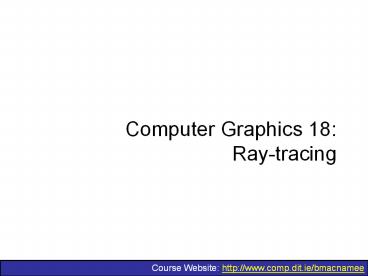Computer Graphics 18: Ray-tracing PowerPoint PPT Presentation
1 / 22
Title: Computer Graphics 18: Ray-tracing
1
Computer Graphics 18Ray-tracing
2
Contents
- Today we will have a look at ray-tracing which
can be used to generate extremely realistic images
3
Ray-Tracing Examples
4
Ray-Tracing Examples (cont)
5
Ray-Tracing Examples (cont)
6
Ray-Tracing Examples (cont)
7
Ray-Tracing Examples (cont)
8
Ray-Tracing Setup
9
Basic Ray-Tracing
- Ray tracing proceeds as follows
- Fire a single ray from each pixel position into
the scene along the projection path - Determine which surfaces the ray intersects and
order these by distance from the pixel - The nearest surface to the pixel is the visible
surface for that pixel - Reflect a ray off the visible surface along the
specular reflection angle - For transparent surfaces also send a ray through
the surface in the refraction direction - Repeat the process for these secondary rays
10
Terminating Ray-Tracing
- We terminate a ray-tracing path when any one of
the following conditions is satisfied - The ray intersects no surfaces
- The ray intersects a light source that is not a
reflecting surface - A maximum allowable number of reflections have
taken place
11
Ray-Tracing Illumination Models
- At each surface intersection he illumination
model is invoked to determine the surface
intensity contribution
12
The Shadow Ray
- The path from the intersection to the light
source is known as the shadow ray - If any object intersects the shadow ray between
the surface and the light source then the surface
is in shadow with respect to that source
13
Ray-Tracing Transparent Surfaces
- For transparent surfaces we need to calculate a
ray to represent the light refracted through the
material - The direction of the refracted ray is determined
by the refractive index of the material
14
Ray-Tracing Tree
- As the rays ricochet around the scene each
intersected surface is added to a binary
ray-tracing tree - The left branches in the tree are used to
represent reflection paths - The right branches in the tree are used to
represent transmission paths - The trees nodes store the intensity at that
surface - The tree is used to keep track of all
contributions to a given pixel
15
Ray-Tracing Tree Example
16
Ray-Tracing Tree Example (cont)
17
Ray-Tracing Tree (cont)
- After the ray-tracing tree has been completed for
a pixel the intensity contributions are
accumulated - We start at the terminal nodes (bottom) of the
tree - The surface intensity at each node is attenuated
by the distance from the parent surface and added
to the intensity of the parent surface - The sum of the attenuated intensities at the root
node is assigned to the pixel
18
Ray Tracing Demo
Theres a very nice Java demo which allows us
step through the ray-tracing process available
at http//www.siggraph.org/education/materials/Hy
perGraph/raytrace/rt_java/raytrace.html
19
Summary
20
(No Transcript)
21
(No Transcript)
22
(No Transcript)

